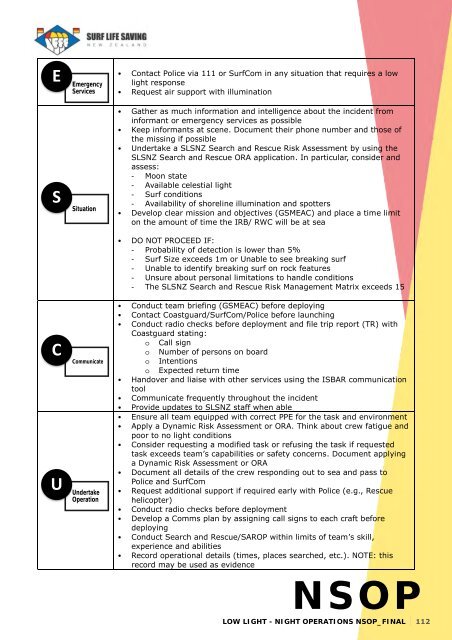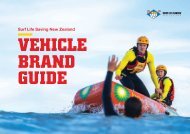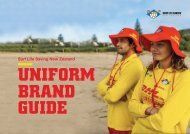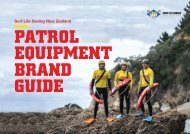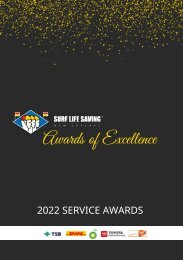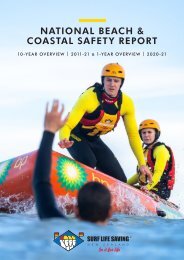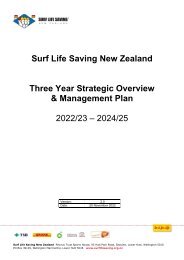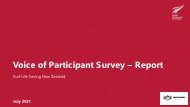National Standard Operating Procedures - Jul 2022
Full NSOP Manual
Full NSOP Manual
You also want an ePaper? Increase the reach of your titles
YUMPU automatically turns print PDFs into web optimized ePapers that Google loves.
spaces is extremely low. Evidence has shown that during a time of Covid community spread, health<br />
care workers are more likely to be exposed to Covid via their household and social contacts than<br />
from their patients. This is even more likely to be the case with surf lifeguards. Lifeguard-to-patient<br />
transmission remains a concern for Covid-19 but also other infectious diseases, as surf lifeguards<br />
may well have no symptoms but still be infectious to colleagues and patients.<br />
5.0 PROCEDURES<br />
Administering first aid to patients will mean that social distancing will not be able to be achieved.<br />
When surf lifeguards/patrol support members are administering first aid they must always be<br />
wearing medical gloves.<br />
When entering an indoor facility (club first aid room) a face mask must also be worn.<br />
Emergency care/first aid should all be managed outside or in a well-ventilated area. If possible, only<br />
one patrol member on the patrol should be administering first aid.<br />
5.1 Minor First Aid<br />
- Follow Pre-First Aid Protocol (5.4)<br />
- If possible, give the patient/caregiver self-management with guidance from a<br />
distance.<br />
- Equipment cleaned after use.<br />
5.2 Major First Aid<br />
- Follow Pre-First Aid Protocol (5.4).<br />
- Ambulance called ASAP.<br />
- Managed by Advanced First Aid qualified (refreshed) first aiders where possible.<br />
- Equipment cleaned after use.<br />
5.3 Providing CPR<br />
- Follow Pre-First Aid Protocol (5.4).<br />
- Ambulance called ASAP.<br />
- Managed by Advanced First Aid qualified (refreshed) first aiders where possible.<br />
- Where possible, avoid mouth-to-face shield and mouth-to-pocket mask ventilation.<br />
Use a bag-valve-mask (BVM) device with a viral filter attached instead.<br />
- Avoid unnecessary proximity to the patient. Space and open ventilation decrease risk<br />
to the patient as well as the lifeguard.<br />
- Place face masks on yourself and the patient as soon as practicable.<br />
- Equipment cleaned after use.<br />
5.4 Pre-First Aid Protocol<br />
Because Covid-19 & other infectious diseases can be spread from individuals without<br />
symptoms, it is safest to wear a mask and other recommended PPE. When possible, place a<br />
face mask (Surgical mask/disposable) on the patient or ask the patient to put on a facemask,<br />
avoid indoor spaces, and maintain distance.<br />
NSOP<br />
EMERGENCY CARE NSOP_FINAL<strong>2022</strong> 105


